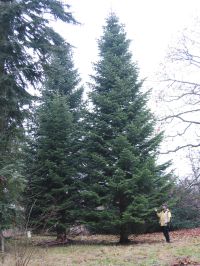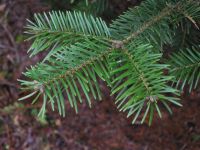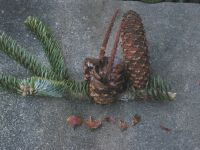Trojan fir - Abies nordmanniana ssp. equi-trojani
English name:
Trojan fir
Scientific name:
Abies nordmanniana ssp. equi-trojani
Family:
Pinacee (Pine)
Height:
25 - 30 M
Flowering:
Spring
Range:
Kaz-Dagh, Ulu-Dagh, northwest Asiatic Turkey
 |
|
 |
 |
The plant in the photograph can be found by the Arboretums lake road (Søvejen) in square 1508 position 2029.
Plant description:
The genus Abies is an important member of the Pine family. The genus has a natural range in much of the northern hemisphere south to Morocco in Africa, south to Viet Nam and Taiwan in Asia and south to Honduras in Central America. True firs (or silver firs) occur in two main ecological zones. Most occur as pure forest stands in boreal or subalpine zones. A few occur in the warm temperate zone as groves or scattered trees in association with oaks. The genus Abies is reported to comprise 48 species, 7 subspecies and 24 varieties plus one nothospecies (hybrid species).
Abies nordmanniana subsp. equi-trojani was first discovered in 1883 by the Greek botanist P. Sintenis on the northern slopes of Mt. Ida (Kaz-Dagh). Judging from the trees in the Arboretum it has the potential to produce excellent Christmas trees in Denmark. However it suffers by being a favoured food of roe deer. Strong browse lines can be seen on our younger trees because of the high deer population last winter.
Needles are spreading below the shoots while those above form a V groove in shaded shoots in the bottom half of the tree. This contrasts with the other subspecies of A. nordmanniana, subsp. nordmanniana, where some upper needles tend to overlap the twig they sit on when viewed from above. The 1.5 to 3 cm long needles have a blunt tip which can be notched when the tree is young.
The female cones are a rich brown and about 13 cm long on maturity. They have clearly visible extended bracts. This year was the first time we have seen cones on any of our three, 26-year-old trees.
The Arboretums 6 living specimens range in age from 8 to 43 years in age. Our oldest specimen occurs by the lake road quite close to the trees used for the pictures shown here.
References:
Liu,T.-S. 1971. A Monograph of the Genus Abies. National Taiwan University pub. 608 pp.
Farjon, A. 2001. World Checklist and Bibliography of Conifers. Royal Botanic Gardens, Kew publishers. 309 pp.
